By Ursula Maxwell-Lewis
Remember those model railway sets Santa used to deliver every Christmas? Well, those little boys grew up, retired, and went back to playing with trains in St. Jacobs, Ontario.
St. Jacobs & Aberfoyle Model Railway co-founder Frank Dubery’s grandson, Mike Craig, proudly oversees 2,400 feet of O gage track winding its way through a thriving (handcrafted) model community. A freight train snakes through a tunnel, a passenger train arrives from behind perfectly proportioned commercial buildings, the show hall dims, and 400 miniature lights twinkle in buildings. Tiny passengers glide serenely by in lighted carriages.
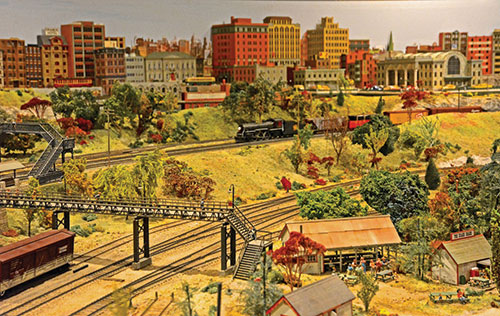 From the control office above the sprawling country scene, Mike carefully negotiates the intricacies of this family work of working art.
From the control office above the sprawling country scene, Mike carefully negotiates the intricacies of this family work of working art.
When visiting St. Jacobs, make sure you put this railway on your itinerary. Find detailed information online at http://www.stjacobsmodelrailway.com
On a larger rail scale, Britain’s National Railway Museum celebrated its 40th anniversary.
Like the model railway in Ontario, the British museum reminded me that few modern-day children have experienced the thrill of riding the rails.
Digging into the National Rail Museum site I find that it’s the largest UK rail museum, houses ‘300 years of history and 1,000,000 objects that changed the world’. Next July a First World War 100 year commemorative anniversary exhibit will open at the NRM. Ambulance trains will be among the many highlights. I’m guessing those alone will be worth visiting.
Something I am familiar with is the locomotive legend, the Flying Scotsman. Having undergone a £4m restoration project, the famous steam engine is scheduled to make its inaugural run from London Kings Cross to York next February. You can follow the final pictorial details at www.nrm.org.uk/flyingscotsman
As a child travelling between Scotland and England I was one of the league of ‘train spotters’ glued to British Rail carriage windows clutching booklets containing pictures of the most famous trains and lists of numbers of all the trains in the systems.
Steaming into ancient Victorian stone stations we’d note train numbers in a notebook, before entertaining ourselves by crossing them off in official Train Spotter books purchased from WH Smith’s for about a shilling and sixpence (25 cents these days?). The Flying Scotsman featured prominently in the books. Being lucky enough to spot it generated general jubilation. What an easy way to keep kids entertained and making friends on a long dusty journey. Of course, nowadays trains could be tracked electronically thereby eliminating the need to converse with anyone, or even glance out of the window.
London’s King’s Cross opened in 1852. It’s been upgraded, of course, but whenever I’m there I feel as though I’m on the verge of a great adventure…or a missed train.
Saltcoats Central, the Scottish North Ayrshire station we often departed from when I was a child, was opened in 1840 and actually was moved twice – once in 1858 and again1882. It’s a grey, stolid sort of station. Beauty isn’t one of its attributes, but my memories surrounding it linger on.
I’ve traversed Canada from Montreal to Vancouver on VIA Rail (the CPR route) for the princely sum of $99 one-way, rattled around assorted destinations throughout Europe, and chugged through South Africa from Johannesburg to Durban or Cape Town more than once.
Last summer my two-year-old Albertan granddaughter excitedly waved to trains rolling through White Rock. She’d be much more excited to actually climb onboard. For now, though, the Bear Creek Park Train, or the Fraser Valley Heritage Rail Interurban will have to suffice.
As I write this a distant train whistle blasts through the night. I think of train dining cars complete with silver service, white-jacketed stewards, kippers and scrambled eggs, businessmen hidden behind The Times, or Telegraph, and English countryside zipping by. Doubtless that costs a bonny penny these days, but I think dining on rolling stock takes the cake. The same goes for coffee and croissants at high speed on France’s TGV, or snacks on Swiss Rail twisting hither and yon around Alps and through mountain tunnels. No wonder Agatha Christie planted her famous sleuth, Poirot, onboard the Orient Express. I wonder if the Amtrak Cascades service to Seattle would offer the same allure. Perhaps we’ll meet onboard and find out.
– Ursula Maxwell-Lewis is a retired editor and photographer
 Article & photos by Lenora A.Hayman.
Article & photos by Lenora A.Hayman. The Tsu Chi Foundation hosted the popular Traditional Chinese Medical Practitioners, one of whom was Alfred Man offering Cancer focused acupuncture immune support and Jane Wang whose strong fingers found stress knots in my neck.
The Tsu Chi Foundation hosted the popular Traditional Chinese Medical Practitioners, one of whom was Alfred Man offering Cancer focused acupuncture immune support and Jane Wang whose strong fingers found stress knots in my neck.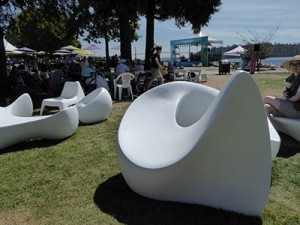 In the Art Market, Xwa lack tun (Rick Harry) from Squamish had carved a beautiful door in yellow and red cedar and abalone, paying homage to the eagle, salmon, mountain and canoe, survivors of the great flood. Also at Ambleside Park is his steel sculpture, Spirit of the Mountain, conveying the positive relationship between the Squamish First Nation and new arrivals to West Vancouver. Xwa lack tun has received the Queens Diamond Jubilee Medal and the FANS Distinguished Artist Award.
In the Art Market, Xwa lack tun (Rick Harry) from Squamish had carved a beautiful door in yellow and red cedar and abalone, paying homage to the eagle, salmon, mountain and canoe, survivors of the great flood. Also at Ambleside Park is his steel sculpture, Spirit of the Mountain, conveying the positive relationship between the Squamish First Nation and new arrivals to West Vancouver. Xwa lack tun has received the Queens Diamond Jubilee Medal and the FANS Distinguished Artist Award. wood.
wood. I always look forward to the Wednesday evening Best of the West, 12 wineries, 12 restaurant food grazing on Ambleside Pier. Guests voted the PARC Retirement Living 1st place for their favorite gourmet taste of vegan wild mushroom tart with smoked chipotle and Kraus farm blackberry reduction. I liked the pairing of the 2012 Stag’s Hollow red tempranillo with the flavours of blackberry, cherry fruit and pomegranate.
I always look forward to the Wednesday evening Best of the West, 12 wineries, 12 restaurant food grazing on Ambleside Pier. Guests voted the PARC Retirement Living 1st place for their favorite gourmet taste of vegan wild mushroom tart with smoked chipotle and Kraus farm blackberry reduction. I liked the pairing of the 2012 Stag’s Hollow red tempranillo with the flavours of blackberry, cherry fruit and pomegranate.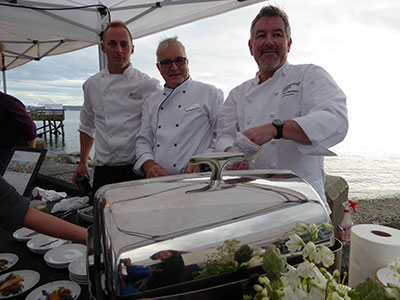 arty on Thursday afternoon. We all dressed in white and were seated at tables set with white linen tablecloths and fresh flowers. We noshed on cucumber sandwiches, salmon pinwheels, ham croissants, scones filled with cream and raspberry jam and blueberry and strawberry tarts. While enjoying David’s speciality teas and sipping a glass of wine a gentleman”90 years young”, in white jacket and white shorts, was swing dancing, to the music of the Slipped Disc Jazz Band. All ages had fun!
arty on Thursday afternoon. We all dressed in white and were seated at tables set with white linen tablecloths and fresh flowers. We noshed on cucumber sandwiches, salmon pinwheels, ham croissants, scones filled with cream and raspberry jam and blueberry and strawberry tarts. While enjoying David’s speciality teas and sipping a glass of wine a gentleman”90 years young”, in white jacket and white shorts, was swing dancing, to the music of the Slipped Disc Jazz Band. All ages had fun!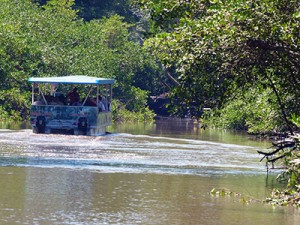 By Rick Millikan
By Rick Millikan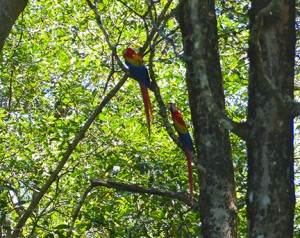 He then points out several green iguanas. “A delicacy, locals love to eat these now endangered reptiles. Hunting these ‘chicken of the trees’ is forbidden,” he smiles. “Hungry? Nowadays, farmers are allowed to raise them for food!”
He then points out several green iguanas. “A delicacy, locals love to eat these now endangered reptiles. Hunting these ‘chicken of the trees’ is forbidden,” he smiles. “Hungry? Nowadays, farmers are allowed to raise them for food!”
 At the end of the boardwalk is a flight of about 50 wooden stairs going up the hill to Rice Lake at the edge of the Lynn Headwaters Regional Park. This man-made lake was once the reservoir providing drinking water for North Vancouver. Today it is a wildlife refuge. Although I didn’t have time to walk around the lake, I saw herons, ducks and an eagle soaring above. A couple were sitting quietly on the float dock, fly fishing
At the end of the boardwalk is a flight of about 50 wooden stairs going up the hill to Rice Lake at the edge of the Lynn Headwaters Regional Park. This man-made lake was once the reservoir providing drinking water for North Vancouver. Today it is a wildlife refuge. Although I didn’t have time to walk around the lake, I saw herons, ducks and an eagle soaring above. A couple were sitting quietly on the float dock, fly fishing